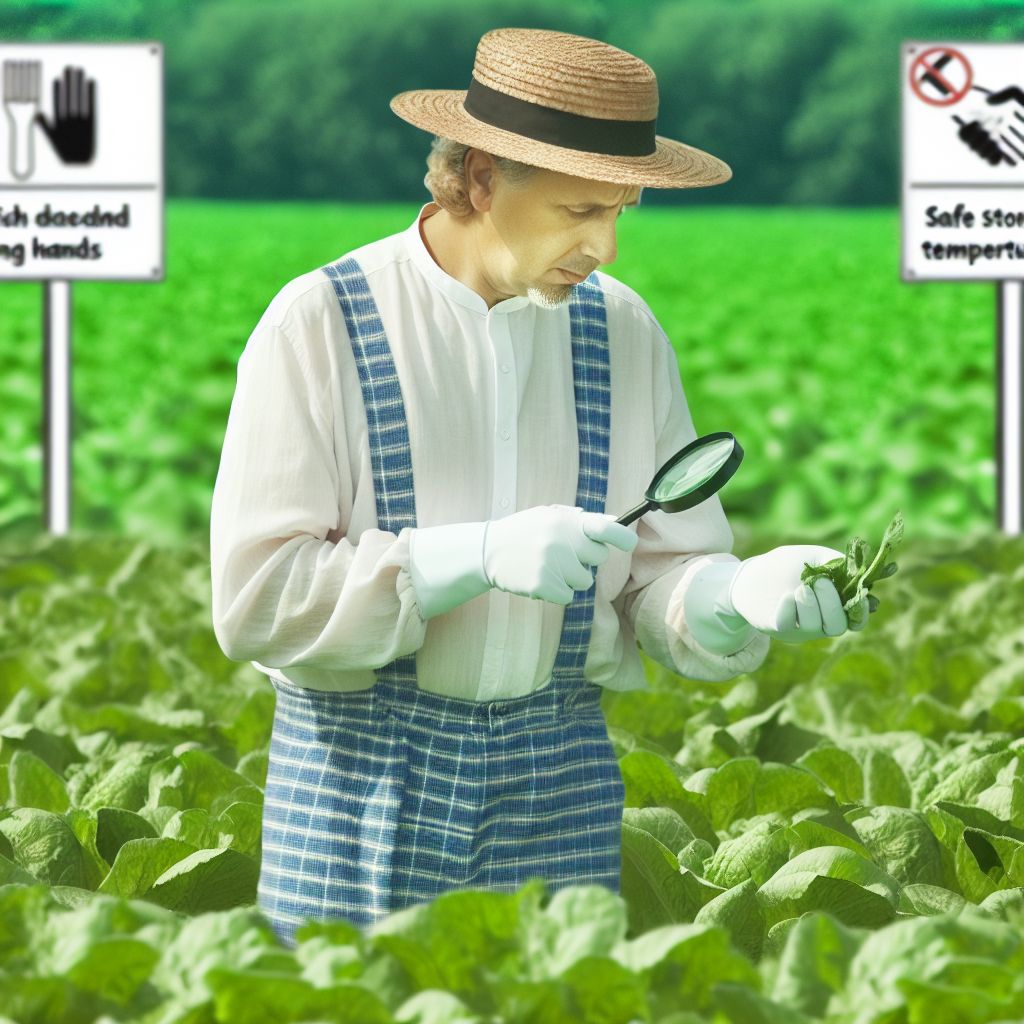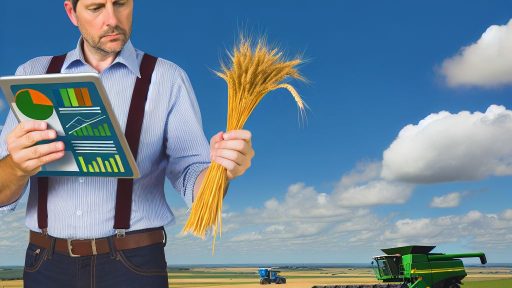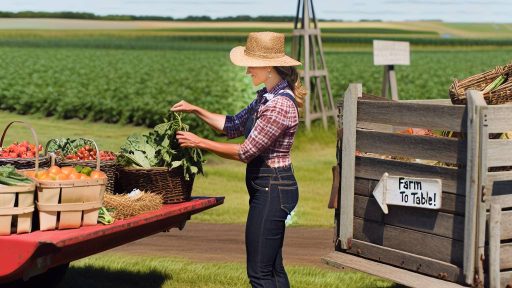Introduction to Food Safety Standards and Their Importance in Agriculture
Food safety standards are critical for agricultural success.
They help protect public health by ensuring food is safe to consume.
Furthermore, these standards enhance consumer confidence in food products.
Adherence to food safety regulations reduces the risks of foodborne illnesses.
Consequently, farmers can avoid costly recalls and lawsuits.
Implementing such standards improves market access for agricultural products.
It opens up new avenues for farmers to sell their goods.
Understanding Food Safety Standards
Food safety standards encompass various regulations and guidelines.
These regulations cover all aspects of production, processing, and handling.
They include standards set by agencies like the FDA and USDA.
Additionally, international guidelines from organizations like WHO play a role.
Proper hygiene practices are a core component of food safety standards.
Impact on Farm Profitability
Complying with food safety standards drives profitability for farmers.
It enhances product quality, leading to higher market prices.
Robust safety practices reduce waste and losses in production.
Transform Your Agribusiness
Unlock your farm's potential with expert advice tailored to your needs. Get actionable steps that drive real results.
Get Started- This practice boosts overall efficiency on the farm.
- Moreover, it fosters consumer loyalty to brands that prioritize safety.
Furthermore, a solid reputation for safety can attract new customers.
As a result, farmers can cultivate stronger relationships with buyers.
Ultimately, food safety standards contribute to sustainable business practices.
Overview of Common Food Safety Standards for Farms
Importance of Food Safety Standards
Food safety standards play a crucial role in agriculture.
They protect consumers from foodborne illnesses.
Moreover, these standards enhance trust in food systems.
Subsequently, adopting them can lead to improved sales.
Global Food Safety Initiative
The Global Food Safety Initiative (GFSI) provides a framework for compliance.
It encourages organizations to continually improve food safety practices.
This initiative helps companies manage risks effectively.
Additionally, it fosters collaboration among key stakeholders.
Good Agricultural Practices
Good Agricultural Practices (GAP) focus on environmental and economic sustainability.
These practices minimize risks to food and water supply.
They cover key aspects like soil management and pest control.
Implementing GAP can lead to higher product quality.
Food and Drug Administration Regulations
The FDA sets regulations that ensure safe food production.
These guidelines apply to growing, harvesting, and processing food.
Farms must comply with these regulations to avoid penalties.
Consequently, adhering to them promotes consumer confidence.
Hazard Analysis Critical Control Point
Hazard Analysis Critical Control Point (HACCP) is a proactive approach.
It identifies potential hazards throughout food production processes.
Implementing HACCP helps mitigate risks effectively.
Furthermore, it serves as a competitive advantage in the marketplace.
ISO Certifications
ISO certifications enhance operational efficiency and product quality.
Showcase Your Farming Business
Publish your professional farming services profile on our blog for a one-time fee of $200 and reach a dedicated audience of farmers and agribusiness owners.
Publish Your ProfileThey require farms to meet specific international standards.
These certifications can open doors to new markets.
Overall, they promote best practices in food safety management.
The Relationship Between Food Safety and Market Access
Importance of Food Safety Standards
Food safety standards play a crucial role in agriculture today.
They ensure that products meet health regulations.
Moreover, these standards protect consumers from foodborne illnesses.
Link Between Food Safety and Market Opportunities
Adopting food safety standards enhances market access.
Many retailers prioritize suppliers who follow these standards.
Consumers increasingly want safe, high-quality products.
Regulatory Requirements
Government regulations influence market access significantly.
For instance, countries have strict import requirements for food safety.
Meeting these regulations can open new markets for farmers.
International Trade and Standards Compliance
International trade agreements often include food safety commitments.
Compliance with these standards boosts credibility in foreign markets.
Conversely, failing to comply can lead to trade barriers.
Consumer Confidence and Demand
Implementing food safety measures increases consumer confidence.
Consumers are more likely to purchase products they trust.
High demand for safe products can lead to better profitability.
Case Studies of Successful Implementation
Farmers who adopted safety standards saw increased sales.
For example, Green Valley Farms gained market entry in Europe.
They achieved this by meeting stringent safety requirements.
Challenges in Implementation
While adopting standards is beneficial, it poses challenges.
Small farmers may struggle with the costs of compliance.
Additionally, continuous education is necessary to stay updated.
Future Trends in Food Safety
The demand for food safety is likely to grow.
Emerging technologies will enhance traceability and transparency.
Farmers must prepare to adapt to evolving regulations.
Find Out More: Farm Waste Management Regulations
Steps for Implementing Food Safety Practices on the Farm
Assess Current Practices
Begin by reviewing your farm’s current food safety practices.
Identify areas that require improvement or changes.
Engage staff in discussions about safety concerns.
Gather feedback to understand existing challenges.
Create a Food Safety Plan
Develop a detailed food safety plan tailored to your farm.
This plan should outline specific goals and practices.
Include protocols for handling and storing food safely.
Ensure your plan adheres to local regulations.
Train Employees
Implement training programs for all employees.
Focus on proper food handling techniques to minimize risks.
Provide resources to reinforce training content.
Regularly update training based on new guidelines.
Showcase Your Farming Business
Publish your professional farming services profile on our blog for a one-time fee of $200 and reach a dedicated audience of farmers and agribusiness owners.
Publish Your ProfileImplement Monitoring Procedures
Establish monitoring procedures to ensure compliance.
Regularly check equipment and storage areas for safety.
Document findings and take corrective actions as needed.
Keep records of inspections and issues encountered.
Engage in Continuous Improvement
Pursue continuous improvement in your food safety practices.
Regularly review and update your food safety plan.
Stay informed on best practices in the industry.
Encourage employee feedback to identify new areas for improvement.
Discover More: Comparing Types of Agricultural Insurance for Your Farm
Cost-Benefit Analysis of Adopting Food Safety Standards
Evaluating the Costs of Implementation
Implementing food safety standards requires an upfront financial investment.
Farmers must allocate resources for training staff on new practices.
Additionally, purchasing new equipment can be necessary to meet safety regulations.
Ongoing costs may include regular audits and quality assurance programs.
Transitioning to safer practices may temporarily disrupt production schedules.
Identifying Potential Benefits
Adopting food safety standards can significantly enhance product quality.
Higher quality products lead to improved consumer trust and loyalty.
Additionally, farms can reduce foodborne illnesses through safer practices.
As a result, they may experience fewer recalls and associated losses.
This proactive approach can also open new market opportunities for farmers.
Calculating Long-Term Financial Gains
Long-term investments in food safety often lead to higher profitability.
Increased safety can result in better prices for produce in local markets.
Moreover, a strong food safety reputation can attract more customers.
Over time, farmers may see decreased liability and insurance costs.
Furthermore, compliance with regulations may minimize legal risks.
Balancing Costs and Benefits
A detailed cost-benefit analysis helps farmers make informed decisions.
They should consider both quantitative and qualitative factors in their evaluation.
Regularly reviewing this analysis can help adjust strategies as needed.
Ultimately, the shift towards better food safety enhances both health and profitability.
Learn More: Understanding Pesticide Withdrawal Periods

Case Studies: Successful Implementation of Food Safety Standards in Farming
Overview of Successful Farms
Farmers around the world are adopting food safety standards.
These standards improve product quality while boosting profitability.
Several successful case studies illustrate this trend.
Case Study: Green Valley Farms
Green Valley Farms implemented comprehensive food safety protocols.
They trained staff in hygiene and proper handling techniques.
As a result, product recalls dropped significantly.
Sales increased by 25% within the first year.
This farm now serves as a model for others in the region.
Case Study: Fresh Harvest Organics
Fresh Harvest Organics focused on traceability systems.
They adopted digital tracking of produce from farm to table.
This transparency built trust with their customers.
Showcase Your Farming Business
Publish your professional farming services profile on our blog for a one-time fee of $200 and reach a dedicated audience of farmers and agribusiness owners.
Publish Your ProfileConsequently, consumer loyalty grew immensely.
Sales revenue improved by 30% due to increased customer confidence.
Case Study: Sunny Acres Dairy
Sunny Acres Dairy emphasized animal welfare and safety standards.
They maintained stringent sanitation protocols in their facilities.
This attention to detail enhanced their product quality.
As a result, Sunny Acres gained premium market pricing.
Their profitability soared due to reduced waste and higher margins.
Common Practices Leading to Success
Successful farms share key practices that enhance safety and profitability.
- Regular training for employees on safety protocols.
- Consistent monitoring of sanitation practices.
- Investment in technology for traceability.
- Transparent communication with customers about safety measures.
- Collaboration with food safety agencies for best practices.
Find Out More: Environmental Considerations In Pesticide Use
Challenges and Solutions in Maintaining Food Safety Compliance
Understanding Common Challenges
Farmers face numerous challenges in food safety compliance.
Strict regulations often change, making it difficult to keep up.
Many farmers lack access to resources for training and education.
Additionally, funding for compliance initiatives can be limited.
Technology Integration
Using technology can significantly enhance food safety practices.
Farm management software helps track and manage compliance efforts.
Innovative sensors monitor conditions in real-time.
Moreover, data analytics can identify potential risks before they escalate.
Training and Education
Equipping staff with essential knowledge improves compliance rates.
Regular training sessions keep everyone informed on best practices.
Engaging with local agricultural extension services can provide valuable insights.
Communities can also host workshops to share knowledge and resources.
Building a Culture of Food Safety
Creating a culture of food safety is vital for long-term success.
This begins with leadership emphasizing the importance of compliance.
Encouraging open communication fosters a proactive approach to safety.
Furthermore, recognizing and rewarding compliant behaviors boosts morale.
Developing Effective Protocols
Structured protocols simplify the adherence to food safety regulations.
Establishing clear procedures reduces the risk of human error.
Regularly reviewing and updating these protocols is crucial.
Involving all staff in this process encourages accountability and diligence.
Utilizing External Resources
External resources can provide crucial support for compliance efforts.
Partnering with food safety consultants brings specialized expertise.
Networking with other farmers can facilitate shared strategies and solutions.
Additionally, government agencies often offer valuable assistance and grants.
The Role of Technology in Enhancing Food Safety and Farm Profitability
Introduction to Technological Advancements
Technology plays a crucial role in modern agriculture.
It helps farmers enhance food safety through various innovative solutions.
Moreover, technology can significantly boost farm profitability.
Precision Agriculture Tools
Precision agriculture uses data analytics for informed decision-making.
Farmers deploy sensors to monitor soil conditions.
This approach allows for tailored irrigation and fertilization practices.
As a result, crop yields improve while reducing waste.
Showcase Your Farming Business
Publish your professional farming services profile on our blog for a one-time fee of $200 and reach a dedicated audience of farmers and agribusiness owners.
Publish Your ProfileBlockchain for Transparency
Blockchain technology ensures traceability in the food supply chain.
This transparency builds consumer trust in product safety.
Farmers can verify product origin and safety standards easily.
Consequently, they can command better prices for high-quality products.
Automation and Robotics
Automation reduces labor costs in farming operations.
Robots can handle tasks like planting, harvesting, and packaging.
These technologies minimize human error and enhance efficiency.
Ultimately, this leads to increased farm productivity and profitability.
Data Management Systems
Advanced data management systems collect and analyze farm data.
Farmers can track crop health and predict market trends effectively.
This information helps in making proactive decisions.
As a result, they can optimize both production and profits.
Implementing Food Safety Standards
Adopting food safety standards is essential for all farmers.
Technology helps streamline compliance with these standards.
Farmers can use software to document processes and track inspections.
This thorough record-keeping increases overall farm reliability.
Future Directions in Agricultural Technology
Incorporating technology in farming enhances food safety and profitability.
As farmers embrace these innovations, they improve their competitive edge.
Thus, technology is vital for a sustainable and profitable agricultural future.
Additional Resources
CAP at a glance – European Commission




